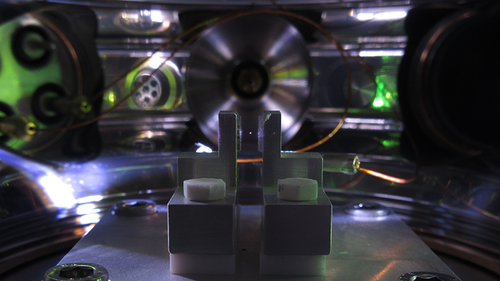
Wright Lab associate professor of physics David Moore and his collaborators Daniel Carney (Physics Division, Lawrence Berkeley National Laboratory and Kyle Leach (Department of Physics, Colorado School of Mines, and Facility for Rare Isotope Beams, Michigan State University) have proposed mechanical quantum sensor technologies to make ultra-sensitive measurements that can detect elusive particles known as neutrinos.
The group has published a paper in “PRX Quantum” (chosen as an “Editor’s suggestion”) called “Searches for massive neutrinos with mechanical quantum sensors” that demonstrates that “a single nanometer-scale, optically levitated sensor operated with sensitivity near the standard quantum limit can search for heavy sterile neutrinos in the keV-MeV mass range with sensitivity significantly beyond existing constraints” and explores the “possibility that mechanical sensors operated well into the quantum regime might ultimately reach the sensitivities required to provide an absolute measurement of the mass of the light neutrino states”.
The SIMPLE search for heavy neutrinos
Since neutrinos interact so weakly, typical neutrino detectors require very large (and therefore also very expensive) experimental setups, such as in the 170-ton MicroBooNE experiment, developed in part due to Wright Lab’s contribution to the technology and analysis of the experiment, and the multi-ton experiment nEXO that the Moore group is currently involved in developing.
In contrast, one of the Moore group’s experiments, Search for new Interactions in a Microsphere Precision Levitation Experiment (SIMPLE), is a tabletop experiment that fits in a room at Wright Lab, but, as demonstrated in the paper above, can also be used to study interactions involving neutrinos. SIMPLE uses “optical tweezers,” in which a laser optically levitates, controls, and measures micron-sized spheres (“microspheres”). By measuring the motion of the microsphere, the group can precisely detect extremely tiny impulses (smaller than 1 quadrillionth of the momentum transferred by a feather landing on your shoulder). This sensitivity is sufficient to measure the momentum recoil of the entire particle if even a single neutrino escapes following the decay of a nucleus inside a nanoparticle with diameter around 100 nanometers.
The Moore group, including postdoctoral associate Thomas Penny, who is setting up the next-generation SIMPLE “trap,” are working to optimize SIMPLE’s search for the neutrino by implanting nuclei that decay by emitting neutrinos in the nanoparticles trapped in SIMPLE. Existing traps for nanoparticles of this size have now demonstrated sensitivity at the “standard quantum limit”, where measurement constraints from quantum mechanics provide the main uncertainty in the measurement. Future extensions beyond this ‘limit’ may even be possible using quantum “squeezing” technologies for the experiment’s sensors, analogous to those used in the sensors of Wright Lab’s HAYSTAC experiment that searches for dark matter, another mysterious phenomenon in physics. This squeezing effect allows quantum uncertainty to be moved into a variable that does not affect the result of the experiment, allowing the sensitivity to be even further improved.
Moore said, “Researchers in Europe have recently demonstrated the ability to use nanometer-scale optically levitated sensors like those of SIMPLE to do quantum measurements; our group is proposing to apply these quantum technologies to nuclear physics.”
How it works – measuring momentum with mechanical sensors
While SIMPLE will not directly detect the neutrino itself, momentum conservation requires that when the neutrino escapes the nanoparticle, the tiny momentum recoil of the entire particle allows for reconstruction of the total momentum of all emitted particles, including the neutrino and other neutral particles that may escape detection in traditional detectors.
Moore explained that the recoil effect is similar to when “you are standing on a skateboard and throw a baseball; you go backwards because of the conservation of momentum”. This backward movement is measurable and would allow you to determine properties of the baseball, without measuring the baseball itself.
State-of-the-art techniques using mechanical sensors now allow the measurement of the momentum of a levitated nanoparticle in the quantum regime. These techniques are now sensitive enough to measure the momentum of a single neutrino emitted from such a nanoparticle. If an anomalous momentum were measured for even a tiny fraction of such decays, it could indicate the existence of a previously undetected heavy type of neutrino.
SIMPLE will observe and measure the momentum transfer of nuclei that decay by decays emitting neutrinos (such as nuclear beta decay), by implanting these nuclei in tiny nanoparticles and shining a laser at the nanoparticle during the decay process. When the neutrino is emitted, the entire nanoparticle moves by a tiny amount, and the nanoparticle motion can be detected through precise measurements of the photons bouncing off of it from the laser. Since the photons used to measure the sphere also carry momentum (and they also push on the nanoparticle), the act of measuring the nanoparticle position provides the limiting uncertainty on its recoil, as required by the Heisenberg uncertainty principle. However, measurements of the nanoparticle recoil at the level given by Heisenberg uncertainty would allow properties of the neutrino to be inferred, including whether any decays emit neutrinos with a larger mass than expected.
A single trapped nanoparticle containing specific isotopes of interest for such decays could provide world leading searches for heavy neutrinos in only a month of integration time.
The future potential of these techniques is significant. Extending the same ideas to large arrays of nanoparticles could probe many orders of magnitude beyond the reach of existing searches for heavy neutrinos. While beyond the state-of-the-art, future extensions of these ideas may allow even the masses of the lighter neutrinos to be determined with similar techniques.

